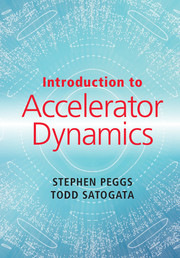Book contents
- Frontmatter
- Dedication
- Contents
- Preface
- 1 Introduction
- 2 Linear Motion
- 3 Strong Focusing Transverse Optics
- 4 Longitudinal and Off-Momentum Motion
- 5 Action and Emittance – One Particle or Many?
- 6 Magnets
- 7 RF Cavities
- 8 Linear Errors and Their Correction
- 9 Sextupoles, Chromaticity and the Hénon Map
- 10 Octupoles, Detuning and Slow Extraction
- 11 Synchrotron Radiation – Classical Damping
- 12 Synchrotron Radiation – Quantum Excitation
- 13 Linacs – Protons and Ions
- 14 Linacs – Electrons
- 15 The Beam–Beam Interaction and 1-D Resonances
- 16 Routes to Chaos
- Appendix A Selected Formulae for Accelerator Design
- References
- Index
Preface
Published online by Cambridge University Press: 08 August 2017
- Frontmatter
- Dedication
- Contents
- Preface
- 1 Introduction
- 2 Linear Motion
- 3 Strong Focusing Transverse Optics
- 4 Longitudinal and Off-Momentum Motion
- 5 Action and Emittance – One Particle or Many?
- 6 Magnets
- 7 RF Cavities
- 8 Linear Errors and Their Correction
- 9 Sextupoles, Chromaticity and the Hénon Map
- 10 Octupoles, Detuning and Slow Extraction
- 11 Synchrotron Radiation – Classical Damping
- 12 Synchrotron Radiation – Quantum Excitation
- 13 Linacs – Protons and Ions
- 14 Linacs – Electrons
- 15 The Beam–Beam Interaction and 1-D Resonances
- 16 Routes to Chaos
- Appendix A Selected Formulae for Accelerator Design
- References
- Index
Summary
This book addresses the single particle dynamics heart of the question; ‘How does an accelerator work?’, for readers who are accelerator users and operators, who are accelerator physicists or who are interested in real-world linear and nonlinear difference systems. The reader might be a synchrotron light source user, a collider experimentalist, a medical accelerator operator, an engineer in a beam instrumentation group or a controls professional in industry.
The level of the discussion is appropriate for graduate students, final-year undergraduates and practicing accelerator professionals. This is not an exhaustively complete reference handbook, at a high technical level. Rather, it is a pedagogical introduction to the subject, telling a self-contained and accurate story about a field of physics that was born and grew rapidly in the second half of the twentieth century, and which continues to mature by leaps and bounds in the twenty first. The treatment is rigorous enough to be accurate and useful, without letting unnecessary detail obscure the central theme. Deeper investigations of the ‘back-stories’ are left to other sources.
The central theme is that repetitive motion through an accelerator is a natural, convenient and well-motivated introduction to the generic linear and nonlinear behaviour of highly iterated difference systems. A circular accelerator – or even a linear accelerator – is one answer to another question: ‘How do difference systems manifest themselves in the real world?’
- Type
- Chapter
- Information
- Introduction to Accelerator Dynamics , pp. xi - xiiPublisher: Cambridge University PressPrint publication year: 2017

